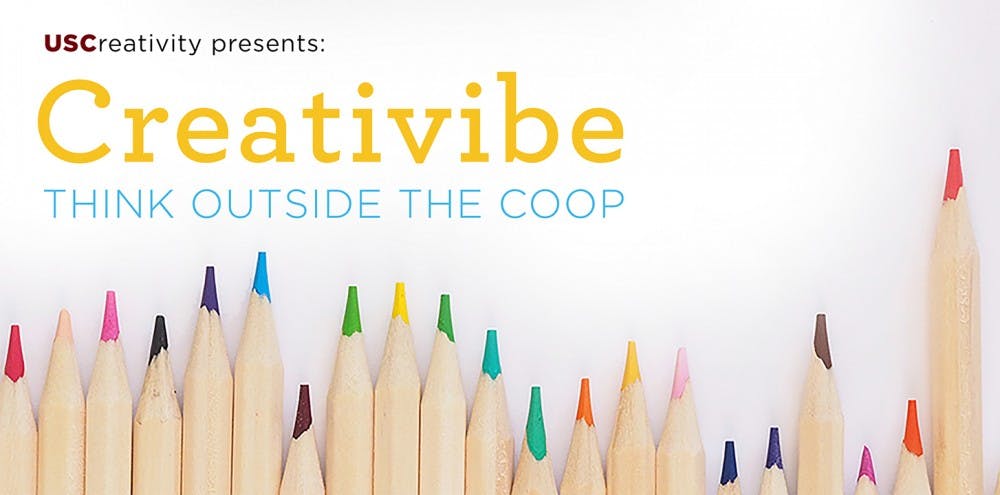When thinking about creativity, images of dance performances or art shows may come to mind. However, USC’s first Creativibe event aims to educate students, faculty and staff about the all-encompassing nature of creativity in its many forms.
The creators of Creativibe describe the event as “part festival, part competition, part think tank.” The event stems from USCreativity, a university initiative to celebrate creativity. Creativibe will include workshops, performances and inspiration talks, all free and open to the public.
David Cutler, director of USCreativity and Creativibe, said the thought process behind this event was the desire to take all aspects of creativity across campus and bring them together for students who may not know where exactly to find them.
“One of the best things about being in a conference of a university, like the University of South Carolina, is there are so many dang smart people and so many resources and so many opportunities,” Cutler said. "Yet, the irony is that — partly because of its size — many of us never experience the greatest thing about it and we get stuck in our bubble, or in our silo, and so we often don’t know what’s going across the hallway, let alone across the street or across campus.”
Cutler also said that Creativibe will express the importance of generating ideas and bringing students out of their bubble of academic study.
“Innovation is rarely about just coming up with an idea out of thin air, but it usually involves taking an idea from one place and applying it somewhere else — but how can you ever get a fresh idea if you don’t go anywhere else?” Cutler said. “So we have a major, and our world is around that major, and it’s hard to see outside of that culture because that’s where we’re centered.”
The four main parts of the event are inspiration talks, workshops, performances and exhibits, consisting of over 100 expressions of creativity from dance performances to stand-up comedy to discussions on topics like how to become a millionaire. Additionally, participants will have the chance to win a $100 gift certificate after collecting stickers from each part of the event.
Eugene Suydam, a third-year economics student, is the workshop coordinator for Creativibe. He said workshops will present visitors with the opportunity to learn how to do new things —Chinese calligraphy or latte art to name a couple.
The workshops are each 15 minutes, beginning every five minutes, and come with a catch — the topic is unknown until the workshop begins. Cutler said people tend to lean toward what they already know because they're comfortable there, but taking out the element of choice could lead to unexpected interests.
“By taking out choice, you may just accidentally be forced into something that you absolutely love — and if you don’t like it, it’s only 15 minutes long," Cutler said.
Katherine Ryker, an assistant professor in the School of Earth, Ocean and Environment, is showcasing multiple exhibits at Creativibe. One of these is an augmented reality sandbox with which visitors can interact and play.
The sandbox is filled with 200 pounds of white sand and comes with an Xbox Connect and a projector. Based on how you move the sand, the projector displays a corresponding topographic map and even simulates rain.
Ryker will also bring projects completed by some of her students last semester after she asked them to find ways to tie together geology and art. She said she believes that Creativibe can be beneficial for faculty and staff too, not just students.
"One of the really exciting things about Creativibe is learning about ways that faculty and instructors across campus are already incorporating the arts and creative explorations in different classes,” Ryker said. “Because I think it’s inspiring to get to see that and think, ‘Well, I could do that, too.’”
Sabrina Habib, a professor in the School of Journalism and Mass Communications and the assistant director of Creativibe, said one goal is to highlight the creativity that often occurs behind the scenes or is hidden on campus, particularly with research.
“Students and faculty and staff are used to seeing news and achievements that are research-oriented, but we often overlook just how much creativity goes into making the research, how much creativity goes in innovation happening on campus,” Habib said.
Lynsey Keator, a doctoral student and speech-language pathologist, will be representing USC’s Aphasia Lab at Creativibe.
Keator sees Creativibe as an opportunity to educate the public about aphasia, a speech disorder that renders speech comprehension or production difficult. Aphasia is caused by a brain injury that is most commonly brought on by stroke, and Keator says this awareness is much-needed because stroke and stroke mortality rates are particularly high in the South Carolina Midlands area.
Keator’s exhibit will feature research participants who live with aphasia, and those in attendance will have the opportunity to hear their stories.
“They suffered strokes a few years back, and as a result, they both have difficulty communicating, but they’re both heavily involved in our research projects as well as our community events,” Keator said. “I think that’ll be a great way for the public to really see aphasia."
Habib also said Creativibe’s true intention is to inspire and expose people to new experiences..
“Usually those experiences tend to elevate your own desire to create, so we’re hoping with that structure — that unique structure — we’re hoping to provide an experience that will inspire,” Habib said.
Creativibe will take place on March 23 from 1 to 4 p.m. at Longstreet Theatre and the School of Journalism and Mass Communications and is free and open to the public.

